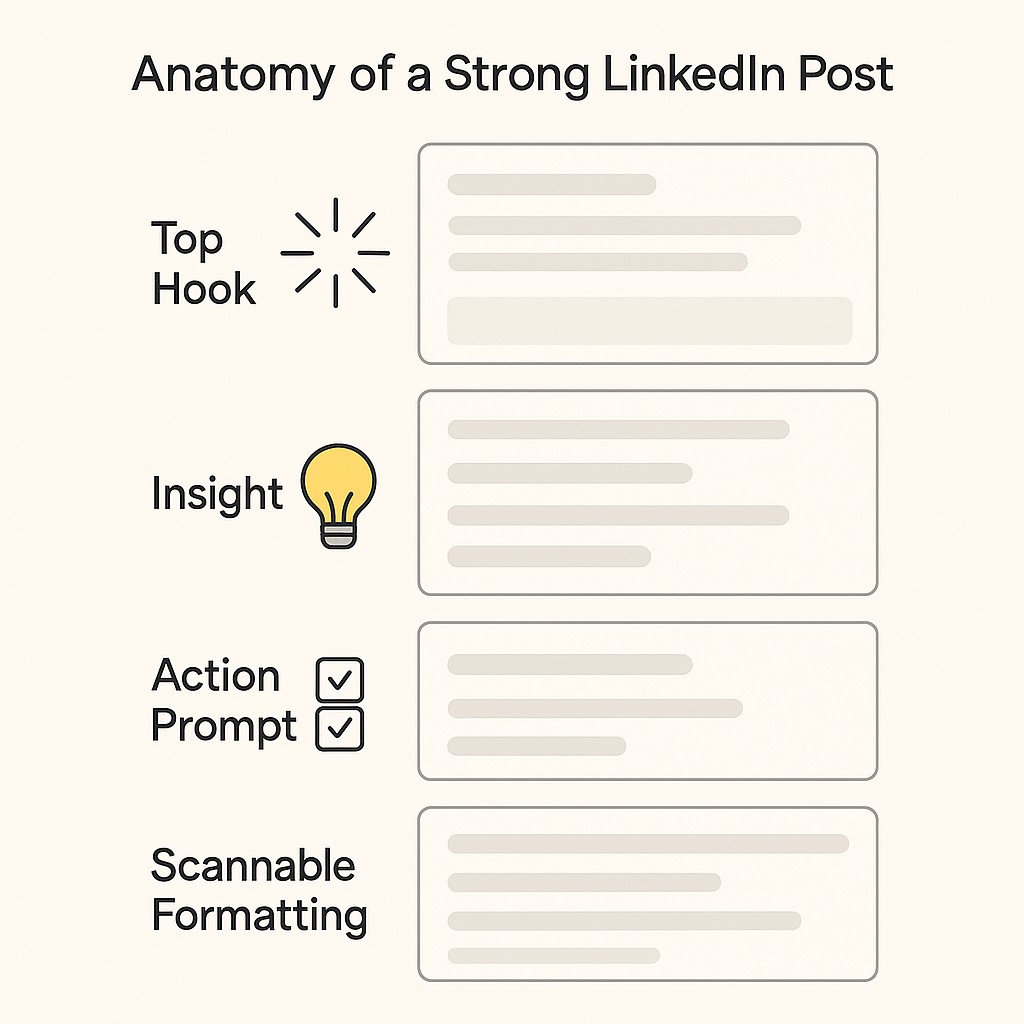Write Engaging LinkedIn Posts That Get Read
Write Engaging LinkedIn Posts That Get Read

The Post I Didn’t Just Toss Off
This morning, right before the first meeting buzzed on my phone, I finished a LinkedIn post about an early mess-up from my first year as a developer. I shared the story—honestly, it’s a little embarrassing even now. But here’s the thing: what I posted wasn’t a quick, off-the-cuff story. I didn’t just write something quickly—I crafted it. I was deliberate about every piece, because intention beats spontaneity when the point is to teach, not just vent. I’ve learned that the hard way.
Mechanically, the decisions weren’t fancy, just disciplined. To write engaging LinkedIn posts, I reworked the opening two lines to trigger the “read more” click and make people curious fast. I dropped in extra white space, even a couple of emojis, so you could scan it at a glance. I didn’t overthink the image—I just picked an old photo from those early days to give it some warmth, so someone skimming would feel a bit of “I know that guy” before even reading.
The core belief behind all this? Good posts don’t just happen. They’re built. We’re not mining for gold nuggets. We’re putting bricks together. If you stick with me here, we’ll package one real story into something someone can actually use. A lesson plus a next step.
If you’ve got experience worth sharing, we’ll make sure people actually read it. That’s the whole game.
Why Useful Posts Still Get Lost
We’ve all been there. You slam out a solid technical breakdown—something real, a fix that saved a stack or an API quirk that bit you twice last year. The lesson’s worth sharing. But here’s the problem I keep seeing (and yes, I’ve done it myself): you hit “Post,” and good advice vanishes into the feed. It’s like your story turned into a changelog entry. No hook, no map, no clear “here’s how to use this.” On a busy morning scroll, those posts look dense and aimless. If the next step isn’t obvious, people bounce fast.
So if you’re thinking all that work got ignored because your writing wasn’t sharp enough, let me reframe it. Writing actually makes the lesson valuable. But packaging is the difference between getting read and getting skipped. Both matter if you want the right people to read, save, and discuss your work. Writing is how you share value; posting is how you make people pay attention.
I get the hesitation. At first, packaging felt weirdly artificial to me too. Who wants to spend an hour making their post look “catchy”? And isn’t that just marketers’ stuff? I used to worry it would take ages or come off as fake. But what changed for me: treating posts like products actually made it simpler. You design the main point, polish the structure, drop in a next step. Framing cuts down back-and-forth, which stabilizes outputs. That means less wasted effort and more clarity, for you and anyone reading.
So here’s what we’ll do next. We’re going to craft effective LinkedIn posts as lightweight releases—quick, deliberate, and built to get seen.
Blueprint: Four Moves to Write Engaging LinkedIn Posts That Land
Start with one real story. Not a generic “lesson learned”—an actual moment that happened to you, because specificity makes people lean in. After that, distill just one insight: what’s the core thing this moment taught you? Then, name a concrete action—something a reader can do (or at least think about) today. Last piece: layer in attention mechanics. That means your hook grabs in two lines, your writing’s tight, formatting is scannable, and you drop in a visual, clear call to action, plus timing that helps more people see it. If it sounds formulaic, good. That repeatable clarity is the whole point.

The hook is everything on LinkedIn, so explore LinkedIn hook ideas that spark curiosity. If your first two lines don’t get a “see more” click, you’re sunk. Compare “Early in my career, I learned a lot about failure” with “Four minutes before a code deploy, I realized my hands were shaking and the rollback script wasn’t tested.” The first is wallpaper. The second is a door you want to walk through. The second line, in particular, can’t go over 33 characters—that’s exactly where the ‘see more’ cutoff hits on LinkedIn. So craft it until it begs you to keep reading.
I talk out loud while editing. Too vague, too slow, too many words. Try nailing the stakes, getting uncomfortably specific, teasing the fix—not the whole answer. You’re not writing mystery novels, just enough to spark curiosity.
Every post needs one teachable insight. No more. If you found out why your rollback broke, just say it plainly. “I skipped testing local scripts because I assumed the environment matched.” One lesson, delivered without hedging or padding. You want readers to see exactly what changed for you, not a laundry list.
Give readers something they can do next. The simplest action beats a perfect plan. If your lesson is “test your rollback,” then literally say: “Next time you prep a deploy, run your rollback in staging—don’t wait until disaster.” Or just ask, “What’s your rollback drill lately?” There’s a reason I always add CTAs to inspire engagement—it pushes people past nodding into actually moving.
Cut fluff, tighten every sentence, and use LinkedIn post formatting so scanning isn’t effort. Most LinkedIn users read posts in an F-shaped pattern, vertical then horizontal, so building for the F-shaped reading pattern puts scannability first—that’s why web content works. Use short paragraphs, patches of white space, maybe a single emoji. Don’t do dense blocks or formal intros. You’re helping busy pros get value in ten seconds.
A visual changes everything—it’s instant context, human warmth, even a hint of credibility. Toss in a relevant photo (your screen, your desk, that blurry team selfie) so people feel the human not just the lesson. Then pay attention to timing: posting between 10:00 AM and 12:00 PM lands your story in LinkedIn’s prime exposure window (timing data). I admit, I launched this on a Tuesday for max reach throughout the week, and yes—I check how it travels after. Posting with intent multiplies impact, instead of letting a good story sink quietly.
So that’s the LinkedIn post framework. One story, one insight, one action, layered with precision mechanics. When you build posts this way, your field-worn lessons don’t just get out there—they actually get read, remembered, and, if you’re lucky, acted on.
Turn One Technical Moment Into a Post That Moves People
Here’s what I always tell engineers looking to share something useful. Start with one vivid experience, not a bland generalization. Maybe you recently had to roll back a deploy—classic panic, right? The lesson you took away might sound obvious when you say it out loud: “Decouple deployments from releases so you don’t ship drama with new features.” Sketch the arc for yourself first. What exactly triggered the mess? Who did it affect? Then write a hook so sharp people want to know how this story ends.
Don’t be coy—list the mistake, flash the lesson fast, and land with one clear next step. For me, this process used to feel a little like prepping a release candidate. I’d rough out the moment (“Rollback at midnight, nothing tested, sweating bullets”), test the hook (“Ever skipped rollback tests because ‘it’ll be fine’?”), state the insight plain (“Never tie deploys and releases together—disaster waits for coupling.”), and wrap with an action (“Today: Separate your deploy and release schedules.”) The rest is attention mechanics, which means formatting for scan speed and emotional grip—every time.
Let me show you the difference a crisp structure makes. Here’s a sketch you can repurpose immediately:
Hook: “Got burned last night by my own deploy—rollback script hadn’t seen daylight in months.”
Context: Was racing to push a minor UI fix.
Insight: Always test rollback scripts on staging before production, even if it’s just a tiny change.
Next Step: Ask yourself: When’s the last time you ran your rollback?
(White space matters. Each line stands alone so readers don’t trip over complexity and miss the punch.)
And here’s the callback. What felt “extra” when you wrote your own story this morning—like swapping in a personal photo or reworking the opening for curiosity—is actually what elevates it above the technical noise. Each detail you bake into the structure is a signal: “This is for you, and it’s worth your time.”
Now, a weird aside. Midway through my third year, I accidentally named two different classes “Manager” in the same project—one for users, one for settings. It didn’t break anything until we onboarded a new teammate, and suddenly everyone was confused why the “Manager” didn’t do what they expected. Took us an entire afternoon to untangle. Funny thing is, I still have to resist that urge to use the obvious name because it always feels efficient in the moment—like posting fast without crafting the hook. The little shortcuts always come due.
Final checks before you hit “Post”: add a relevant photo (phone snap is fine), follow a LinkedIn CTA strategy with one clear ask (“What’s your rollback drill?”), and be ruthless about those first two lines. If they don’t spark enough curiosity for a ‘read more’ click, rewrite them. Time the post for when your network’s active—LinkedIn’s traffic spikes late morning. Treat the ‘read more’ hook as gospel. If you nail it, you get the engagement that keeps your lesson alive.
If you use this simple checklist, you’ll learn how to write engaging LinkedIn posts so your next story won’t just be useful. It’ll be seen, saved, and discussed by the pros that matter to you.
Ready to apply this blueprint without staring at a blank screen—use our AI to draft hooks, tighten copy, and spin up post-ready formats you can edit fast and ship with confidence.
Addressing Time, Authenticity, and Making Packaging Second Nature
Let’s talk about the time. Yes, packaging your story takes a few more minutes than just dumping your thoughts into a box and hitting post. But it’s the best investment you can make if your goal is real impact. Well-structured stories travel farther—people save them, share them, and come back weeks later. That compounds. One post that lands right can bump opportunities your way that a dozen unpolished posts never spark. Minutes now trade for network reach and later doors opening.
I get the unease around authenticity. Making a lesson legible isn’t faking it—it’s the craft of clear thinking. It’s you, but readable. Think of it like naming a function well: not showboating, just making your signal unmistakable for whoever picks it up next. That’s not theater—it’s care.
Here’s how I’ve made packaging automatic. I keep a running list of story seeds in my notes app—tiny moments, not whole stories yet. On Mondays, I batch out a handful of hook lines. Then, when it’s time to post, I give myself a 20-minute sprint to draft (checklist always on hand), and I publish on Tuesdays for max visibility. It isn’t a heavy lift. It’s just routine.
But, honestly, I haven’t always managed to stick to this habit. Some weeks, I slip and just jot bullet points instead of stories. I know it matters, but I still trip up when things get busy. Maybe that’s just part of it.
Decide to craft your posts deliberately. That’s how you get your expertise seen, saved, and carried forward—just like the LinkedIn post I built this morning, and just like you can, starting now.
Enjoyed this post? For more insights on engineering leadership, mindful productivity, and navigating the modern workday, follow me on LinkedIn to stay inspired and join the conversation.
You can also view and comment on the original post here .
